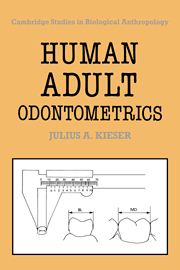Book contents
- Frontmatter
- Contents
- Foreword
- Preface
- 1 Introduction
- 2 Measurement of tooth size
- 3 Inheritance of tooth size
- 4 Comparative odontometry
- 5 Odontometric trends
- 6 Sexual dimorphism in tooth size
- 7 Odontometric variability
- 8 Compensatory tooth size interactions
- 9 Fluctuating odontometric asymmetry
- 10 Allometric relations of tooth size
- Odontometric appendix
- References
- Index
6 - Sexual dimorphism in tooth size
Published online by Cambridge University Press: 05 February 2012
- Frontmatter
- Contents
- Foreword
- Preface
- 1 Introduction
- 2 Measurement of tooth size
- 3 Inheritance of tooth size
- 4 Comparative odontometry
- 5 Odontometric trends
- 6 Sexual dimorphism in tooth size
- 7 Odontometric variability
- 8 Compensatory tooth size interactions
- 9 Fluctuating odontometric asymmetry
- 10 Allometric relations of tooth size
- Odontometric appendix
- References
- Index
Summary
Introduction
Sexual dimorphism refers to those differences in size, structure and appearance between males and females of a given species or subspecies at an equal age and, where relevant, during the same season (Thompson, 1964). Although males and females of many species differ markedly by the time they reach maturity, they bear a close resemblance to one another at birth. Prenatally, at two months gestational age, the human foetus is morphologically neither male nor female, dimorphism developing under the influence of androgens between months four and six (Dorner & Kawakami, 1978; Hughes & Lambert, 1984).
As they grow and develop, the sexes of a given species begin to differ in size, plumage, colour, behaviour and form. The task of understanding the meaning and origin of differences between male and female organisms of a given species has occupied the most brilliant biological minds for centuries. For ease of reference, sexual dimorphism may be divided into three levels. At the most fundamental level are the primary sexual characters that distinguish the sexes: the testes of males and the ovaries of females. Primary sex characters are essential to the process of sexual reproduction, by means of which new individuals are formed that contain genetic material from more than one source (Margulis & Sagan, 1984).
At the second level are those external features that distinguish males from females. These characters function as releasers of social reactions intimately connected to courtship and mating and are referred to as secondary sexual characters. Examples of these abound and range from the bizarre structural elaborations found in the tail feathers of peacocks to often mundane contrasts in colouring between males and females.
- Type
- Chapter
- Information
- Human Adult OdontometricsThe Study of Variation in Adult Tooth Size, pp. 63 - 73Publisher: Cambridge University PressPrint publication year: 1990
- 1
- Cited by



